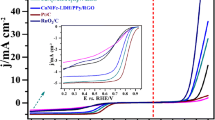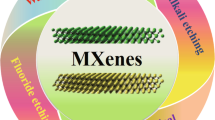Abstract
Hydrogen evolution reaction (HER) plays a vital role in renewable energy conversion for the development of hydrogen-based energy sources. Lately, heterostructures through hybridizing MXenes with two-dimensional materials have been successfully fabricated and attract much attention due to the exceptional performance as electrodes for Li ion storage and electrocatalysts for HER. Herein, we constructed heterostructures of CoNx-graphene (CoNx-G, x = 2 and 4) supported by MXenes (Ti3C2F2 and Ti3C2O2) monolayer as highly active electrocatalysts for HER. The theoretical results show that the CoN2-G/Ti3C2O2 heterostructure exhibits a high performance for HER with an over-potential (Ƞ) of only 0.33 V, and the rate-limiting step is determined to be the initial water dissociation process in alkaline media. The outstanding performance of CoN2-G/Ti3C2O2 is strongly attributed to the interfacial coupling between CoN2-G and the MXene substrate. Our finding demonstrates that the sluggish hydrogen evolution process in alkaline media can be facilitated by taking advantage of the fast charge transfer kinetics and interfacial coupling of MXenes.
Graphic abstract
Herein, we theoretically design and explore 2D hybrid materials of CoNx–G supported by MXene monolayers as highly active HER electrocatalysts by using first-principles calculations. The results show that the CoN2–G/Ti3C2O2 heterostructure has an outstanding HER performance with ΔGH* (0.21 eV) approaching zero as well as water molecule dissociation barrier (ΔGH–OH) of 0.30 eV in alkaline media. This exceptional performance is strongly attributed to the interfacial coupling between CoN2–G and the MXene substrate.






Similar content being viewed by others
Change history
20 March 2021
A Correction to this paper has been published: https://doi.org/10.1007/s10800-021-01551-3
References
Marbán G, Valdés-Solís T (2007) Towards the hydrogen economy? Int J Hydrogen Energy 32:1625–1637. https://doi.org/10.1016/j.ijhydene.2006.12.017
Muradov N, Veziroǧlu T (2005) From hydrocarbon to hydrogen-carbon to hydrogen economy. Int J Hydrogen Energy 30:225–237. https://doi.org/10.1016/j.ijhydene.2004.03.033
Izquierdo U, Barrio V, Cambra J et al (2012) Hydrogen production from methane and natural gas steam reforming in conventional and microreactor reaction systems. Int J Hydrogen Energy 37:7026–7033. https://doi.org/10.1016/j.ijhydene.2011.11.048
Wang M, Chen L, Sun L (2012) Recent progress in electrochemical hydrogen production with earth-abundant metal complexes as catalysts. Energy Environ Sci 5:6763–6778. https://doi.org/10.1039/C2EE03309G
Nørskov JK, Bligaard T, Logadottir A et al (2005) Trends in the exchange current for hydrogen evolution. J Electrochem Soc 152:J23–J26. https://doi.org/10.1149/1.1856988
Tang Q, Jiang D (2016) Mechanism of hydrogen evolution reaction on 1T-MoS2 from first principles. ACS Catal 6:4953–4961. https://doi.org/10.1021/acscatal.6b01211
Karchiyappan T (2019) A review on hydrogen energy production from electrochemical system: benefits and challenges. Energy Source Part A 41:902–909. https://doi.org/10.1080/15567036.2018.1520368
Hitz C, Lasia A (2001) Experimental study and modeling of impedance of the HER on porous Ni electrodes. J Electroanal Chem 500:213–222. https://doi.org/10.1016/S0022-0728(00)00317-X
Zheng S, Li X, Yan B et al (2017) Transition-metal (Fe Co, Ni) based metal-organic frameworks for electrochemical energy storage. Adv Energy Mater 7:1602733. https://doi.org/10.1002/aenm.201602733
Wang Z, Hao X, Jiang Z et al (2015) C and N hybrid coordination derived Co-C-N complex as a highly efficient electrocatalyst for hydrogen evolution reaction. J Am Chem Soc 137:15070–15073. https://doi.org/10.1021/jacs.5b09021
Crnkovic F, Machado SAS, Avaca LA (2004) Electrochemical and morphological studies of electrodeposited Ni-Fe-Mo-Zn alloys tailored for water electrolysis. Int J Hydrogen Energy 29:249–254. https://doi.org/10.1016/S0360-3199(03)00212-X
You B, Zhang Y, Jiao Y et al (2019) Negative charging of transition-metal phosphides via strong electronic coupling for destabilization of alkaline water. Angew Chem Int Ed 58:11796–11800. https://doi.org/10.1002/anie.201906683
Xu K, Ding H, Zhang M et al (2017) Regulating water-reduction kinetics in cobalt phosphide for enhancing HER catalytic activity in alkaline solution. Adv Mater 29:1606980. https://doi.org/10.1002/adma.201606980
Song Y, Yuan Z (2017) One-pot synthesis of Mo2N/NC catalysts with enhanced electrocatalytic activity for hydrogen evolution reaction. Electrochim Acta 246:536–543. https://doi.org/10.1016/j.electacta.2017.06.086
Lin H, Shi Z, He S et al (2016) Heteronanowires of MoC-Mo2 C as efficient electrocatalysts for hydrogen evolution reaction. Chem Sci 7:3399–3405. https://doi.org/10.1039/C6SC00077K
Jin S (2017) Are metal chalcogenides, nitrides, and phosphides oxygen evolution catalysts or bifunctional catalysts? ACS Energy Lett 2:1937–1938. https://doi.org/10.1021/acsenergylett.7b00679
Ekspong J, Sharifi T, Shchukarev A et al (2016) Stabilizing active edge sites in semicrystalline molybdenum sulfide by anchorage on nitrogen-doped carbon nanotubes for hydrogen evolution reaction. Adv Funct Mater 26:6766–6776. https://doi.org/10.1002/adfm.201601994
Yang Y, Lun Z, Xia G et al (2015) Non-precious alloy encapsulated in nitrogen-doped graphene layers derived from MOFs as an active and durable hydrogen evolution reaction catalyst. Energ Environ Sci 8:3563–3571. https://doi.org/10.1039/C5EE02460A
Cao L, Luo Q, Liu W et al (2019) Identification of single-atom active sites in carbon-based cobalt catalysts during electrocatalytic hydrogen evolution. Nat Catal 2:134–141. https://doi.org/10.1038/s41929-018-0203-5
Naguib M, Mochalin VN, Barsoum MW et al (2014) 25th anniversary article: MXenes: a new family of two-dimensional materials. Adv Mater 26:992–1005. https://doi.org/10.1002/adma.201304138
Alhabeb M, Maleski K, Anasori B et al (2017) Guidelines for synthesis and processing of two-dimensional titanium carbide (Ti3C2Tx MXene). Chem Mater 29:7633–7644. https://doi.org/10.1021/acs.chemmater.7b02847
Couly C, Alhabeb M, Van Aken KL et al (2018) Asymmetric flexible MXene-reduced graphene oxide micro-supercapacitor. Adv Electron Mater 4:1700339–1700346. https://doi.org/10.1002/aelm.201700339
Ding L, Wei Y, Wang Y et al (2017) A two-dimensional lamellar membrane: MXene nanosheet stacks. Angew Chem Int Ed 56:1825–1829. https://doi.org/10.1002/ange.201609306
Naguib M, Come J, Dyatkin B et al (2012) MXene: a promising transition metal carbide anode for lithium-ion batteries. Electrochem Commun 16:61–64. https://doi.org/10.1016/j.elecom.2012.01.002
Wen Y, Rufford TE, Chen X et al (2017) Nitrogen-doped Ti3C2Tx MXene electrodes for high-performance supercapacitors. Nano Energy 38:368–376. https://doi.org/10.1016/j.nanoen.2017.06.009
Zhou S, Yang X, Pei W et al (2018) Heterostructures of MXenes and N-doped graphene as highly active bifunctional electrocatalysts. Nanoscale 10:10876–10883. https://doi.org/10.1039/C8NR01090K
Aïssa B, Ali A, Mahmoud KA et al (2016) Transport properties of a highly conductive 2D Ti3C2Tx MXene/graphene composite. Appl Phys Lett 109:043109–043113. https://doi.org/10.1063/1.4960155
Zhang X, Lei J, Wu D et al (2016) A Ti-anchored Ti2CO2 monolayer (MXene) as a single-atom catalyst for CO oxidation. J Mater Chem A 4:4871–4876. https://doi.org/10.1039/C6TA00554C
Ling C, Shi L, Ouyang Y et al (2016) Transition metal-promoted V2CO2 (MXenes): a new and highly active catalyst for hydrogen evolution reaction. Adv Sci 3:1600180–1600187. https://doi.org/10.1002/advs.201600180
Gao G, Mullane AP, Du A (2016) 2D MXenes: a new family of promising catalysts for the hydrogen evolution reaction. ACS Catal 7:494–500. https://doi.org/10.1021/acscatal.6b02754
Novoselov K, Mishchenko A, Carvalho A et al (2016) 2D materials and van der waals heterostructures. Science 353:9439–9449. https://doi.org/10.1126/science.aac9439
Geim AK, Grigorieva IV (2013) Van der waals heterostructures. Nature 499:419–425. https://doi.org/10.1038/nature12385
Du Y, Kan X, Yang F et al (2018) MXene/graphene heterostructures as high-performance electrodes for li-ion batteries. ACS Appl Mater Inter 10:32867–32873. https://doi.org/10.1021/acsami.8b10729
Yan J, Ren C, Maleski K et al (2017) Flexible mxene/graphene films for ultrafast supercapacitors with outstanding volumetric capacitance. Adv Funct Mater 27:1701264–1701273. https://doi.org/10.1002/adfm.201701264
Zhang B, Liu J, Wang J et al (2017) Interface engineering: The Ni(OH)2/MoS2 heterostructure for highly efficient alkaline hydrogen evolution. Nano Energy 37:74–80. https://doi.org/10.1016/j.nanoen.2017.05.011
Zhang X, Yang Z, Yang X et al (2018) Engineering the activity of CoNx-graphene for hydrogen evolution. Int J Hydrogen Energy 43:20573–20579. https://doi.org/10.1016/j.ijhydene.2018.09.043
Wang S, Zhang L, Qin Y et al (2017) N-codoped graphene as efficient electrocatalyst for hydrogen evolution reaction: Insight into the active centre. J Power Sources 363:260–268. https://doi.org/10.1016/j.jpowsour.2017.07.107
Kresse G, Hafner J (1993) Ab initio molecular dynamics for liquid metals. Phys Rev B 47:558–561. https://doi.org/10.1103/PhysRevB.47.558
Blöchl PE (1994) Projector augmented-wave method. Phys Rev B 50:17953–17979. https://doi.org/10.1103/PhysRevB.50.17953
Perdew JP, Burke K, Ernzerhof M (1996) Generalized gradient approximation made simple. Phys Rev Lett 77:3865–3868. https://doi.org/10.1103/PhysRevLett.77.3865
Grimme S, Ehrlich S, Goerigk L et al (2011) Effect of the damping function in dispersion corrected density functional theory. J Comput Chem 32:1456–1465. https://doi.org/10.1002/jcc.21759
Monkhorst HJ, Pack JD (1976) Special points for Brillouin-zone integrations. Phys Rev B 13:5188–5192. https://doi.org/10.1103/PhysRevB.13.5188
Bai L, Kong L, Wen H et al (2019) First-principle study of high performance lithium/sodium storage of Ti3C2T2 nanosheets as electrode materials. Chin Phys B. https://doi.org/10.1088/1674-1056/ab592e
Medford AJ, Vojvodic A, Hummelshøj JS et al (2015) From the Sabatier principle to a predictive theory of transition-metal heterogeneous catalysis. J Catal 328:36–42. https://doi.org/10.1016/j.jcat.2014.12.033
Acerbi N, Tsang SC, Jones G (2013) Rationalization of interactions in precious metal/ceria catalysts using the d-band center model. Angew Chem Int Ed 52:7737–7741. https://doi.org/10.1002/ange.201300130
Gan L, Zhao Y, Huang D et al (2013) First-principles analysis of MoS2/Ti2C and MoS2/Ti2CY2 (Y = F and OH) all-2D semiconductor/metal contacts. Phys Rev B 87:245307–245313. https://doi.org/10.1103/PhysRevB.87.245307
Chen Z, Huang S, Huang B et al (2020) Transition metal atoms implanted into MXenes (M2CO2) for enhanced electrocatalytic hydrogen evolution reaction. Appl Surf Sci 509:145319. https://doi.org/10.1016/j.apsusc.2020.145319
Hu G, Tang Q, Jiang D (2016) CoP for hydrogen evolution: implications from hydrogen adsorption. Phys Chem Chem Phys 18(34):23864. https://doi.org/10.1039/C6CP04011J
Tang Q, Jiang DE (2016) Mechanism of hydrogen evolution reaction on 1T-MoS2 from first principles. ACS Catal 6(8):4953–4961. https://doi.org/10.1021/acscatal.6b01211
Seh ZW, Fredrickson KD, Anasori B et al (2016) Two-dimensional molybdenum carbide (MXene) as an efficient electrocatalyst for hydrogen evolution. ACS Energy Lett 1(3):589–594. https://doi.org/10.1021/acsenergylett.6b00247
Acknowledgements
This work was supported by the Project of Integration Platform of Industry & Education of Higher Vocational Education in Jiangsu Province—Artificial Intelligence & Internet of Things (AIoT) (Higher Vocational Education in Jiangsu Province [2019] No.26), the Natural Science Foundation of the Jiangsu Higher Education Institutions of China (No. 18KJD140005), and the National Natural Science Foundation of China (Grant No. 11404322).
Author information
Authors and Affiliations
Corresponding authors
Additional information
Publisher's Note
Springer Nature remains neutral with regard to jurisdictional claims in published maps and institutional affiliations.
The original online version of this article was revised: the co-corresponding authorship for the author “Zhengzhong Zhang” is included
Rights and permissions
About this article
Cite this article
Li, S., Wang, Y., Wang, H. et al. Heterostructures of MXenes and CoNx-Graphene as highly active electrocatalysts for hydrogen evolution reaction in alkaline media. J Appl Electrochem 51, 871–878 (2021). https://doi.org/10.1007/s10800-021-01542-4
Received:
Accepted:
Published:
Issue Date:
DOI: https://doi.org/10.1007/s10800-021-01542-4




